日本动漫文化 英文介绍
日本动漫介绍英文版

搞笑
Super Robot Wars
genie(鬼,妖怪)and magic
侦探悬疑
Sports
school
Charateristics of the Anime
1.Anime is adapted from Japanese manga(日 本漫画)
纺织与材料学院 田露 2015011001
Have you watched any anime?
What are they?
Can you speak out the name? What is your favorite anime?
• Japan is the largest anime power in the world. The animation development modle has distinctive(有特色的,与众不同的) ethnic characteristics. Anime began at the start of the 20th century, when Japanese filmmakers experimented with the animation techniques also pioneered in France, Germany, the United States, and Russia.
3)Hair: Anime hair is very stylicized. The most popular hair style is the grass cut, with long strands poking out of the hair. Anime hair also comes in bright unnatural colors, ranging from purple to red, to pink .
日本动漫发展史英语演讲
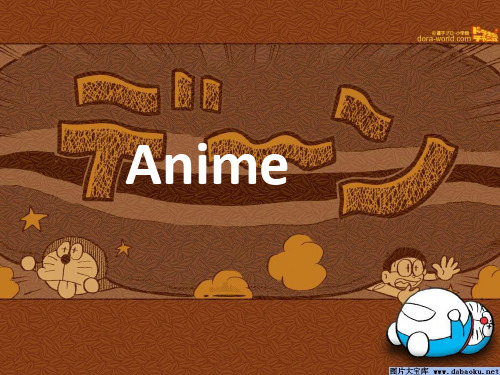
It won the 86 Oscar Award for best animated feature film.and award for best original song.
Japan is the largest anime power in the world. Every year ,Japan produces about 200 animations .At present,60% of the world’s animations are made in Japan .Animation has become one of the pillars of Japan’s economy. The development process of Japan’s anime can be divided into three stages.
——探索期
1974-1989: the mature stage
——成熟期
• In the1970s,Japan emerged a large number of Science Fiction mechanical animations(科幻机械动 画).But ,Miyazaki got rid of the limitation ,and walked out of a natural ,pure and fresh style.
Animation derived to many of the other products
The End《高达OO》《龙猫》风 之 谷
天 空 之 城
1986
1984
龙 猫
魔 女 急 宅 便
1988
1989
幽 灵 公 主
日本动漫文化 英文介绍

classification
children's comics (6 ~ 11 years old children)
youth comics (from 6 to 18 years old for boys the main readers of the comic
girl comics
young comic (18 ~ 25 year old youth )
The Japanese anime, is called the Japanese cartoon and Japanese Caricature.
Japan is the world's largest animation powerful country. Japanese started from 1917,it has 96 years for now.
The history of anime
❖ 1917-1945:the birth of Japanese anime (萌芽期)
❖ 1946-1973:Explore period (探索期)
❖ 1974-1989:Mature period (成熟期)
❖ 1990- now: The refinement phase (细化期)
Байду номын сангаас
1917-1945:the birth of Japanese anime Momotarô: Umi no shinpei 桃太郎海上神兵
1946-1973:Explore period
手冢治虫(1928-1989)
Astro Boy
1974-1989:Mature period
藤子·F·不二雄(1933年-1996年) DORAEMON
日本动漫介绍英文版 (3)

Japanese animation which was import into China in 1980s,was popular as soon as it was shown on TV screen in China.To some extent,we can say that Chinese youths were acompanied with Japanese animation as they were growing up.During this time,Janpanese animation influenced their ideas and consciousness.
The classification of the Japanese anime…
Adventure
Super Robot Wars
hot-blooded
genie
comedy
sports
inference
school
girl
love
The influence of Japanese animations on Chinese youths
Introduce the meaning of some words…
TV anime comic :Animation
works which continuous projected on TV.
OVA: be short for Original Video
Animation, Original intention is original animation video refers to videotape or DVD form directly with the release of the animation works. Later development for “Original Visual Animation” .
日本动漫介绍英文版

D o y o u s till re m e m b e r th e s e ?
In u y a s h a
D e te c tiv e C o n a n
S a ilo r M oo n
C a rd c a p t or S a k u ra
D o ra e m on
T h e in flu e n c e o f J a p a n e s e a n im a tio n s o n C h in e s e y o u th s
J a p a n e s e a n im a tio n w h ic h w a s im p o rt in to C h in a in 1980s ,w a s p o p u la r a s s o o n a s it w a s s h o w n o n T V s c re e n in C h in a .T o s o m e e x te n t,w e c a n s a y th a t C h in e s e y o u th s w e re a c o m p a n ie d w ith J a p a n e s e a n im a tio n a s th e y w e re g ro w in g u p .D u rin g th is tim e ,J a n p a n e s e a n im a tio n in flu e n c e d th e ir id e a s a n d
The classification of the Japanese anime…
A dve nture
Super R obot W a rs
介绍日本的二次元文化英语作文
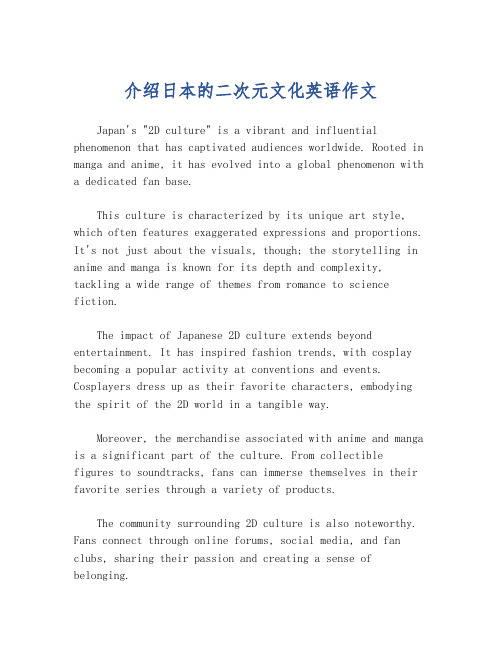
介绍日本的二次元文化英语作文Japan's "2D culture" is a vibrant and influential phenomenon that has captivated audiences worldwide. Rooted in manga and anime, it has evolved into a global phenomenon with a dedicated fan base.This culture is characterized by its unique art style, which often features exaggerated expressions and proportions. It's not just about the visuals, though; the storytelling in anime and manga is known for its depth and complexity, tackling a wide range of themes from romance to science fiction.The impact of Japanese 2D culture extends beyond entertainment. It has inspired fashion trends, with cosplay becoming a popular activity at conventions and events. Cosplayers dress up as their favorite characters, embodying the spirit of the 2D world in a tangible way.Moreover, the merchandise associated with anime and manga is a significant part of the culture. From collectiblefigures to soundtracks, fans can immerse themselves in their favorite series through a variety of products.The community surrounding 2D culture is also noteworthy. Fans connect through online forums, social media, and fan clubs, sharing their passion and creating a sense of belonging.Japanese 2D culture is more than just a form of entertainment; it's a lifestyle for many. It has the power to inspire creativity, foster community, and provide an escape from reality.In conclusion, the allure of Japan's 2D culture lies in its ability to resonate with people on a personal level. It's a testament to the power of storytelling and the universal appeal of art.。
日本动漫介绍英文版(课堂PPT)

1
Do you still remember these?
Detective Conan
2Hale Waihona Puke Inuyasha3
Sailor Moon
4
Cardcaptor Sakura
5
Doraemon
6
7
The history of Japanese anime
• 1917-1945:the birth of Japanese anime • 1946-1973:explore period • 1974-1989:mature period • 1990-now:twenty-first century period
The influence of Japanese animations on Chinese youths
Japanese animation which was import into China in 1980s,was popular as soon as it was shown on TV screen in China.To some extent,we can say that Chinese youths were acompanied with Japanese animation as they were growing up.During this time,Janpanese animation influenced their ideas and consciousness.
8
Introduction in detail
While the earliest known Japanese animation dates to 1917,and many original Japanese cartoons were produced in the ensuing decades, the characteristic anime style developed in the 1960s—notably with the work of Osamu Tezuka—and became known outside Japan in the 1980s. Anime, like manga, has a large audience in Japan and recognition throughout the world. Distributors can release anime via television broadcasts, directly to video, or theatrically, as well as online.
介绍日漫的英语作文

介绍日漫的英语作文English Answer:Japanese manga, also known as Japanese comics, are a vibrant and popular form of entertainment that has captivated audiences worldwide. With its distinct visual style, compelling stories, and diverse genres, manga has become a global phenomenon.Manga originated in Japan in the late 19th century, evolving from earlier forms of sequential art. The term "manga" itself translates to "whimsical pictures" or "capricious drawings," aptly describing the often-exaggerated and playful nature of its visuals.One of the most distinctive features of manga is its unique art style. Manga characters are typically drawn with large, expressive eyes, exaggerated facial expressions, and stylized hair. The panels are often arranged in a dynamic and asymmetrical manner, creating a sense of movement andtension.Manga covers a wide range of genres, including action, adventure, comedy, drama, romance, and horror. Some of the most popular and influential manga series include "Naruto," "Dragon Ball," "One Piece," and "Attack on Titan." These series have captivated readers with their compelling storylines, complex characters, and stunning artwork.Manga is not only a form of entertainment but also a reflection of Japanese culture and society. It often explores themes of identity, belonging, and the human condition. Manga has also played a significant role in popularizing Japanese culture internationally, influencing anime, video games, and other forms of media.In addition to its cultural significance, manga has also had a profound impact on the global comics industry. Its unique visual style and storytelling techniques have influenced comic book artists worldwide, inspiring new forms of expression and pushing the boundaries of the medium.Overall, Japanese manga is a captivating and diverse form of entertainment that has captured the imaginations of countless readers worldwide. Its unique art style, compelling stories, and cultural significance have made ita global phenomenon that continues to inspire and entertain.中文回答:日本漫画,也称为日本漫画,是一种充满活力和受欢迎的娱乐形式,已经吸引了全世界的观众。
各国动漫特点英文介绍
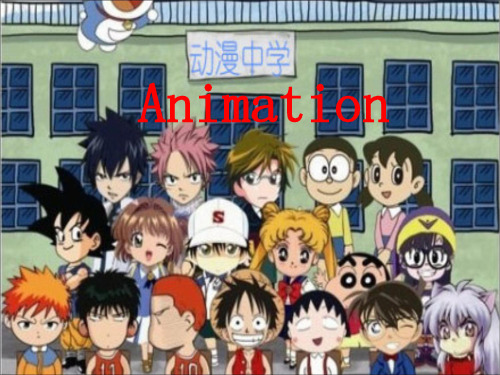
question
Do you know something about animation?
Anime
--In Japanese culture
Japanese anime has 90 years of history, to date, animation has become Japan's third-largest industry, accounting for more than a dozen percentage points from GDP. Japanese animation has a large number of fans in the world. In Japan, regardless of the Government or business, are not merely "animation" as a simple leisure culture, but solid to be treated as an industry to support and development.
ICE
AGE
Anime
--In Chinese culture
Because of chinese Immature business environment, animators always thought that animation is just for kids , and parents involved in the animation was a bit "emotional" aspects of the particularly sensitive , so animation Infant tendency to serious. Moreover, Chinese computer graphics, film and television skills to be improved, and the works of imitation and not biased in favor of the original.
日漫介绍英文作文
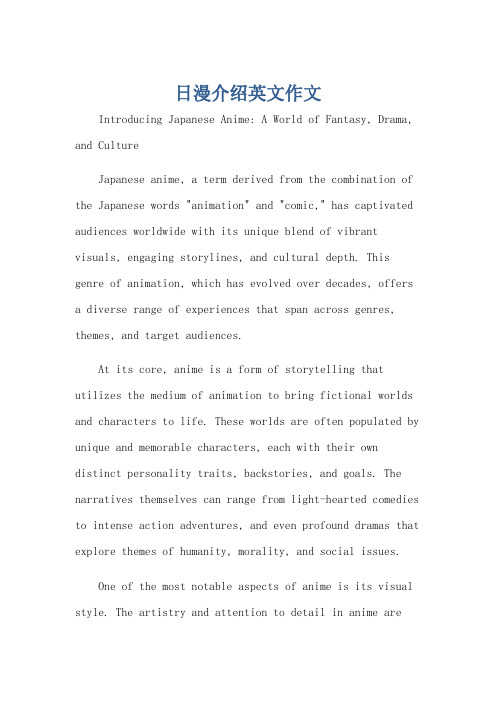
日漫介绍英文作文Introducing Japanese Anime: A World of Fantasy, Drama, and CultureJapanese anime, a term derived from the combination of the Japanese words "animation" and "comic," has captivated audiences worldwide with its unique blend of vibrant visuals, engaging storylines, and cultural depth. This genre of animation, which has evolved over decades, offers a diverse range of experiences that span across genres, themes, and target audiences.At its core, anime is a form of storytelling that utilizes the medium of animation to bring fictional worlds and characters to life. These worlds are often populated by unique and memorable characters, each with their own distinct personality traits, backstories, and goals. The narratives themselves can range from light-hearted comedies to intense action adventures, and even profound dramas that explore themes of humanity, morality, and social issues.One of the most notable aspects of anime is its visual style. The artistry and attention to detail in anime areunparalleled, with each frame often containing intricate designs, vibrant colors, and dynamic action sequences. The character designs are particularly noteworthy, often featuring exaggerated features and expressive facial expressions that help convey emotions and personality traits.In addition to its visual appeal, anime also excels in sound design. The music, voice acting, and sound effects are often tailored specifically for each project, enhancing the viewer's experience and adding depth to the storytelling. The voice actors bring a sense ofauthenticity and emotional weight to their characters, while the music and sound effects create an immersive atmosphere that further enhances the narrative.Another aspect of anime that sets it apart is its cultural influence. Many anime series are based on Japanese folklore, history, and traditions, offering viewers a glimpse into the rich cultural heritage of Japan. Through these stories, anime introduces audiences to a diverse range of themes and ideas that reflect Japanese values, beliefs, and perspectives.Moreover, anime has also become a platform for exploring social and political issues. Many modern anime series tackle timely topics such as environmentalism, gender equality, and social justice, offering thought-provoking commentary on these important issues. By presenting these topics through the medium of animation, anime is able to reach a wide audience and spark meaningful discussions.The popularity of anime has also led to the creation of a vibrant fan culture. Fans of anime often form communities online and offline, sharing their love of the genre through discussions, fan art, and cosplay. These communities provide a space for fans to connect with others who share their interests and to explore the various aspects of anime culture.In conclusion, Japanese anime is a genre that offers a unique and enriching experience for viewers of all ages and backgrounds. Its blend of vibrant visuals, engaging storylines, and cultural depth makes it a captivating form of entertainment that continues to evolve and inspire new generations of fans. Whether you're a long-time fan or justdiscovering the world of anime for the first time, there's sure to be something in this genre that will captivate your imagination and leave you wanting more.。
动漫英语介绍作文

动漫英语介绍作文Anime, the art of Japanese animation, has captured the hearts and minds of people worldwide, transcending cultural barriers and igniting a passion for the extraordinary in all of us. It's more than just a form of entertainment; it's a vibrant, colorful universe filled with intricate storylines, complex characters, and boundless creativity.Origins and EvolutionTracing its roots back to the early 20th century, anime has evolved from simple, black-and-white silent films to the technologically advanced, full-color spectacles we know today. The medium has undergone significant transformations over the years, influenced by various art movements, pop culture trends, and technological advancements. From the pioneering works of Osamu Tezuka, known as the 'God of Manga' and the father of modern anime, to the contemporary masterpieces produced by studios like Studio Ghibli and MAPPA, anime continues to push the boundaries of storytelling and visual art.Diverse Genres and ThemesOne of the most appealing aspects of anime is its vast array of genres and themes. From heartwarming slice-of-life dramas that explore everyday human emotions, to epic fantasy adventures that transportviewers to magical realms, to thrilling action series that keep you on the edge of your seat, there's something for everyone. Anime also tackles deeper themes such as friendship, love, sacrifice, growth, and the struggle between good and evil, often presenting them in a unique and thought-provoking manner.Character Development and StorytellingAnime is renowned for its intricate character development and immersive storytelling. Characters are often multidimensional, with complex personalities and backstories that evolve over the course of the series. Their growth, both emotionally and physically, resonates deeply with audiences, fostering a strong sense of empathy and attachment. The storytelling, meanwhile, is meticulously crafted, weaving intricate plotlines that keep viewers engaged and guessing until the very end.Visual and Artistic StyleVisually, anime is a feast for the eyes. The art styles vary widely, from the traditional hand-drawn cel animation to the modern digital techniques that push the limits of animation. Color palettes are vibrant and imaginative, and the attention to detail in character design, backgrounds, and special effects is unparalleled. Anime also often incorporates unique artistic elements such as traditional Japanese art forms, enhancing the cultural richness of the medium.Global Impact and Fan CultureAnime's global reach is undeniable, with fans spanning across continents and age groups. It has inspired a vibrant fan culture, complete with conventions, cosplay, fan art, and online communities where enthusiasts share their love for the medium. Anime has also had a significant impact on other forms of media, influencing everything from video games to live-action films and even fashion.In conclusion, anime is a treasure trove of imagination, creativity, and storytelling mastery. It's a world where the impossible becomes possible, and the extraordinary is the norm. Whether you're a seasoned anime fan or just discovering this enchanting universe, there's always something new and exciting to explore in the world of anime.。
介绍动漫英文作文

介绍动漫英文作文English:Anime, also known as Japanese animation, is a popular form of entertainment that has attracted a huge international fanbase. It encompasses a wide variety of genres such as action, romance, fantasy, science fiction, and horror, and is characterized by its vibrant art style and compelling storytelling. One of the key aspects of anime that sets it apart from other forms of animation is its ability to appeal to audiences of all ages, from children to adults. Whether it's the heartwarming stories of friendship and adventure in shows like "My Neighbor Totoro" and "Pokémon," or the complex and thought-provoking narratives found in series like "Attack on Titan" and "Death Note," anime has something for everyone. In addition to its diverse range of genres, anime also often features deep and meaningful themes that provoke introspection and self-reflection, making it a powerful medium for conveying important messages and life lessons. With its rich and vibrant culture, anime has become a global phenomenon that continues to captivate audiences around the world.中文翻译:动漫,也被称为日本动画,是一种受到国际粉丝极大喜爱的流行娱乐形式。
介绍日漫的英语作文
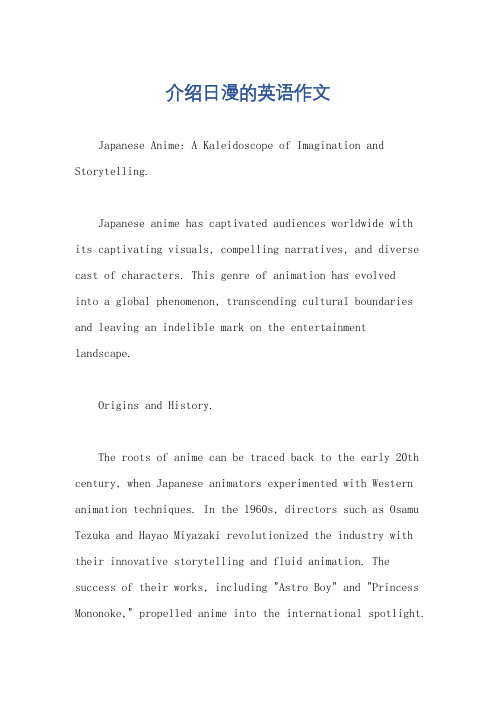
介绍日漫的英语作文Japanese Anime: A Kaleidoscope of Imagination and Storytelling.Japanese anime has captivated audiences worldwide with its captivating visuals, compelling narratives, and diverse cast of characters. This genre of animation has evolvedinto a global phenomenon, transcending cultural boundaries and leaving an indelible mark on the entertainment landscape.Origins and History.The roots of anime can be traced back to the early 20th century, when Japanese animators experimented with Western animation techniques. In the 1960s, directors such as Osamu Tezuka and Hayao Miyazaki revolutionized the industry with their innovative storytelling and fluid animation. The success of their works, including "Astro Boy" and "Princess Mononoke," propelled anime into the international spotlight.Characteristics and Styles.Anime encompasses a vast array of artistic styles, from the exaggerated and cartoonish to the realistic and detailed. Character designs often feature large, expressive eyes and exaggerated body proportions, creating a distinct and recognizable visual aesthetic. The animation is typically fluid and dynamic, with a focus on movement and emotion.Narrative themes in anime vary widely, ranging from action and adventure to romance and slice-of-life. Common elements include the exploration of complex characters, philosophical themes, and the blurring of reality and fantasy. Anime also frequently incorporates elements from Japanese culture, such as traditional festivals, mythology, and folklore.Global Impact.Anime has become a cultural phenomenon, with dedicatedfans in countries around the world. Anime conventions and fan meet-ups attract thousands of attendees, showcasing the enthusiasm and passion for this beloved genre. The global success of anime has led to collaborations between Japanese and foreign studios, resulting in a diverse range of co-productions and adaptations.Anime has also played a significant role in promoting Japanese culture on a global scale. Through its depictions of Japanese society, customs, and traditions, anime has fostered a greater understanding and appreciation for Japan's unique heritage.Economic and Social Significance.The anime industry is a major economic force in Japan, generating billions of dollars in revenue annually. It has created numerous employment opportunities, from animators and voice actors to writers and producers. Anime has also stimulated tourism, with fans traveling to Japan to visit locations featured in their favorite shows.Beyond its economic impact, anime has had a positive social impact, providing a sense of community for fans around the world. It fosters creativity, inspires imagination, and encourages viewers to explore diverse perspectives and cultures.Genres and Subgenres.The anime genre is vast and encompasses a wide range of subgenres, each with its own unique set of conventions and themes. These include:Action: Fast-paced and adrenaline-pumping, featuring intense battles and high-stakes confrontations.Adventure: Explores the unknown, often with a focus on discovery, treasure hunting, and exploration.Romance: Centers on romantic relationships, ranging from lighthearted comedies to epic love stories.Slice-of-Life: Depicts everyday life, exploring themundane and extraordinary moments that shape human experiences.Mecha: Features giant robots controlled by humans, often used in battles or other science fiction scenarios.Fantasy: Immersive worlds filled with magic, mythical creatures, and extraordinary events.Sci-Fi: Explores futuristic technologies, space exploration, and the intersection of science and society.Critical Acclaim and Awards.Anime has received widespread critical acclaim for its artistic excellence, storytelling prowess, and cultural significance. Numerous anime films and series have been nominated for and won prestigious awards, including the Academy Awards, Golden Globes, and Emmys. Directors such as Hayao Miyazaki, Makoto Shinkai, and Mamoru Hosoda have gained international recognition for their groundbreaking contributions to the genre.Conclusion.Japanese anime has emerged as a global cultural force, captivating audiences with its visually stunning animation, engaging stories, and diverse cast of characters. It has not only achieved commercial success but has also fostered a sense of community among fans, promoted cross-cultural understanding, and inspired generations of artists and storytellers. Anime continues to push boundaries, expandits reach, and leave an enduring legacy on the entertainment landscape.。
日本动漫介绍英文版 (3)

Theatre cartoon version:Theaters animation works,
is the Japanese animation according to the classification of the mode of transmission in China is also known as
Introduce the meaning of some words…
TV anime comic :Animation
works which continuous projected on TV.
OVA: be short for Original Video
Animation, Original intention is original animation video refers to videotape or DVD form directly with the release of the animation works. Later development for “Original Visual Animation” .
日本动漫英文作文

日本动漫英文作文I love Japanese anime because it's so unique and creative. The characters are always so interesting and the storylines are often unpredictable. It's a great way to escape from reality and immerse yourself in a different world.The animation in Japanese anime is always top-notch.The attention to detail is amazing and the action scenesare always so exciting. It's no wonder that anime has sucha huge fan base all over the world.One of the things I love most about Japanese anime is the variety of genres available. Whether you're into action, romance, horror, or comedy, there's always something for everyone. It's great to be able to explore different typesof stories and characters within the world of anime.The voice acting in Japanese anime is also somethingthat sets it apart from other forms of animation. The voiceactors bring so much emotion and depth to the characters, and it really adds to the overall experience of watching anime.I also appreciate the cultural aspects that are often present in Japanese anime. It's a great way to learn about Japanese traditions, customs, and even language. It's like getting a glimpse into another culture while being entertained at the same time.Overall, Japanese anime is a fantastic form of entertainment that offers something for everyone. Whether you're a casual viewer or a hardcore fan, there's always something new and exciting to discover in the world of anime.。
日本动漫介绍英语

库· 丘林(Cú Chulainn),原 名瑟坦达(Setanta) ,凯尔 特神话(Celtic mythology) 中太阳神鲁格· 麦克· 埃索伦 (Lugh mac Ethlenn)的儿 子,古爱尔兰盖尔语故事“阿 尔斯特(Ulster)传说”的中 心人物和伟大的英雄之一。
在通过了影之国(Isle of Skye)之 主斯卡哈(Scathach)的考验,学 到了精湛的武艺、兵法。组建了著 名的「赤枝勇士团」(Red Branch),活跃在前线保卫自己的 祖国。
Heian Period (Heian Period) is Japan's last history in ancient times, from 794, huan wu emperor moved the capital from the nara to Heian kyo (Kyoto) now, to 1192 YuanLaiChao set the kamakura shogunate took power.
(Victorian era), between the Georgian and Edward age , it is considered to be the peak of British industrial revolution and the British empire end. It is often defined as the time from 1837 to 1901, the queen Victoria (Alexandrina Victoria) rule. 维多利亚时代(Victorian era),前接乔治时代,后启爱德华 时代,被认为是英国工业革命和大英帝国的峰端。它的时限常 被定义为1837年~1901年,即维多利亚女王(Alexandrina Victoria)的统治时期。
- 1、下载文档前请自行甄别文档内容的完整性,平台不提供额外的编辑、内容补充、找答案等附加服务。
- 2、"仅部分预览"的文档,不可在线预览部分如存在完整性等问题,可反馈申请退款(可完整预览的文档不适用该条件!)。
- 3、如文档侵犯您的权益,请联系客服反馈,我们会尽快为您处理(人工客服工作时间:9:00-18:30)。
classification
children's comics (6 ~ 11 years old children)
youth comics (from 6 to 18 years old for boys the main readers of the comic
girl comics
young comic (18 ~ 25 year old youth )
Famous author
宫崎骏,Miyazaki Hayao (龙猫,千与千寻 spirited away) 高桥留美子Rumiko Takahashi—(犬夜叉 Inuyasha) 尾田龙一郎Oda Ryuichiro-(one piece海贼 王) 乌山明-(龙珠 ) 藤子F不二雄 – (DOபைடு நூலகம்AEMON哆啦A梦) 諫山 創いさやま はじめ-进击的巨人、
手冢治虫(1928-1989) Astro Boy
1974-1989:Mature period
藤子· 不二雄(1933年-1996年) F· DORAEMON
1990- now: The refinement phase
Saint Seiya
Popular reasons
Japanese anime have a strong targeted. Japanese cartoon is classified according to the age and sex of the readers
1974-1989:Mature period (成熟期) 1990- now: The refinement phase (细化期)
1917-1945:the birth of Japanese anime
Momotarô: Umi no shinpei 桃太郎海上神兵
1946-1973:Explore period
.Characteristic and type
: Adventure(冒险) Hot-blood(热血) Super robot war(机战) Funny(搞笑) School(校园) Emotional(情感) Aestheticism(唯美) Cute(卖萌) Detective(侦探) Across(穿越) Fantasy(玄幻) etc.
Anime
------In Japanese culture
1.Origin 2.The history of anime 3.Popular reasons 4.Characteristic and type 5.Famous author
The Japanese anime, is called the Japanese cartoon and Japanese Caricature.
Japan is the world's largest animation powerful country. Japanese started from 1917,it has 96 years for now.
The history of anime
1917-1945:the birth of Japanese anime (萌芽期) 1946-1973:Explore period (探索期)
